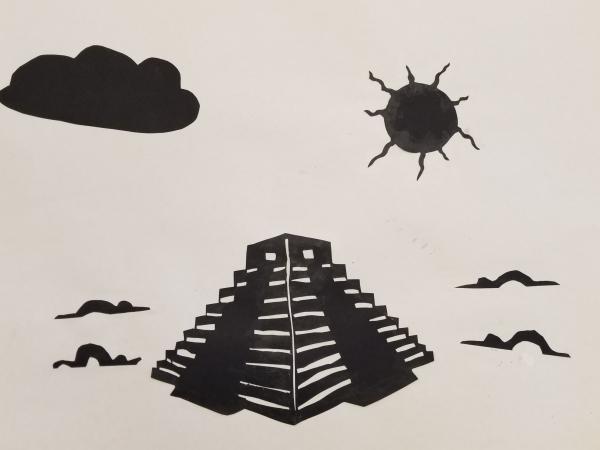Educator Resources
Symbolic Silhouettes
February 9, 2022
Image

Through this project, students explore various religions of the world and create silhouette art.
Students will learn about the history of silhouettes and view silhouette work of contemporary artist, Kara Walker. Students research their chosen religion and determine important symbols and imagery to incorporate into their artwork. Students draw and cut out silhouettes on black paper, then arrange and glue their silhouettes to a large sheet of white paper.
Objectives:
- Students will research their chose religion
- Students will identify important symbols and imagery
- Students will demonstrate knowledge of symbols in the form of silhouettes
- Students will design an artwork using at least three different silhouettes with the goal of communicating the major ideas/themes of their religion.
- Students will write a three-to-four sentence statement about their artwork.
Basic Lesson Outline:
- Introduce the project and share slideshow.
- Discuss symbols and share history of silhouettes
- Students begin researching their religion and identifying which items they will incorporate into their design
- Discuss composition tips as well as safety tips for cutting.
- Students cut their silhouette pieces.
- Students attach silhouette pieces to their white paper to create the overall design.
- Students display their work and artist statement, give feedback and discuss.
Art Supplies:
- pencils and erasers and sharpeners
- black paper
- white paper
- glue sticks
- envelopes to hold silhouette pieces between classes
Other Resources:
- Slideshow to introduce project, related artwork and concepts
- Brainstorming worksheet
Idaho State Learning Standards:
Arts and Humanities: Anchor Standard 1: Generate and conceptualize artistic ideas and work.
- VA:Cr1.2.la: Shape an artistic investigation of an aspect of present-day life using a contemporary practice of art or design.
Arts and Humanities: Anchor Standard 2: Organize and develop artistic ideas and work.
- VA:Cr2.1.lla: Through experimentation, practice, and persistence, demonstrate acquisition of skills and knowledge in a chosen art form.
- VA:Cr2.3.llla: Demonstrate in works of art or design how visual and material culture defines, shapes, enhances, inhibits, and/or empowers people's lives.
World History Goal:
- Students will research the fundamental inspirations of ancient civilizations, many of which revolved around religious and spiritual beliefs, in order to understand why we are here now.
>World History Objective(s):
- I can understand how specific religious and spiritual beliefs influenced the specific culture that I have chosen for my art
- I can use my art and my artist statement to reflect my knowledge of how religion and spiritual practices were inspiring to the civilizations on which my project focused.
Academic Language:
- Subject area language: religion, beliefs, culture, ancient civilizations, practices
- Art language: symbol, silhouette, composition, shape, line, outline, contour line
- How students will use the vocabulary: Students will use the words when creating their silhouettes, when writing about their work in their artist statement, and when discussing their projects.
Vocabulary:
- Students will use the words when creating their silhouettes, when writing about their work in their artist statement, and when discussing their projects.
Student Grouping:
Students will work independently.
Instructions:
Day 1 – Introduction
Introduce the project through the slide show
- Introduce symbols, history of silhouettes and show artist work.
- Engage students by encouraging them to critically think and ask:
o What message do I want to communicate?
o What kinds of symbols are common or important?
o What are the major themes and practices of the religion? - Discuss project goals and expectations.
- Students choose religion then research and brainstorm to begin planning design.
Day 2 – Artmaking
- Students finalize their design plan
- Students begin cutting their silhouette pieces
Day 3 – Artmaking
- Students continue cutting their silhouette shapes and begin assembling.
Day 4 – Artmaking
- Students finish their silhouette design.
- If time allows, they will begin working on their artist statement.
Day 5 – Presentations
- Students will finalize artist statement paragraph.
- Students will display their artwork and artist statement and participate in a gallery walk where they will observe each other’s works and give feedback to at least two of their peer’s work. Class discusses what they observed in their peer’s work.
Slide Show Outline:
- Discussion of silhouettes
- Discussion of symbols
- Religion in Art — examples across the list of religions
- Project goal and education goals
- History of the Silhouette — what it is and visual examples/art
- Contemporary silhouette art — Kara Walker
- Project Goal and Planning — idea/message, symbols, research
- Composition tips
- Cutting safety tips
- Project check in
- Artist statement question prompts to help students write their own artist statement
- Resources
End of Project Artist Reflection and Presentation:
- What religion does your silhouette represent?
- What symbols did you include and why/what do they mean?
- Select another religion (Christianity, Judaism, Islam, Buddhism, Egyptian, Incan/Mayan/Aztec, Hinduism, or spirituality of native peoples) and compare it with your chosen religion:
o How are the two religions different and how are they similar? (Ex: do they pray to more than one god? Do they build temples? Do they include the human form in their art?)
o What else did you notice?
0 comments
Leave a Comment